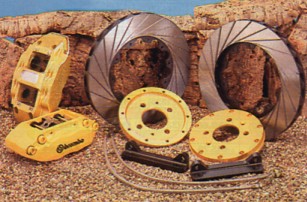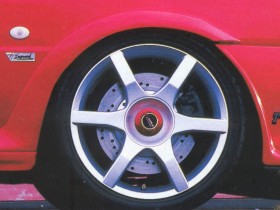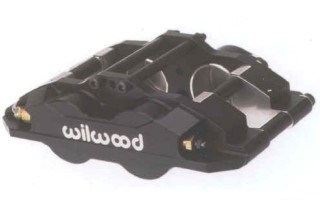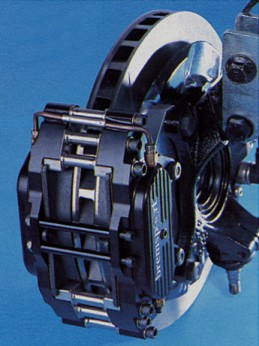|
|
||||||||||||||||
| cosworth discs & calipers | 4 pots | the ultimate? | ||||||||||||||||
| Uprating your brakes is an essential modification to make when increasing the power of your car. Brake upgrades are available in many stages, from aftermarket disc and pads, to full blown 4 pot caliper and large diameter disc conversions. It is also possible to convert the rear drums on a Fiesta to discs. | ||||||||||||||||
| Uprated discs | ||||||||||||||||
| The standard setup on all the Fiestas consists of 240mm vented discs and single pot (piston) calipers. This combination is just about enough to stop the standard car, but totally hopeless for anything quicker. The main problem faced with the standard system is brake fade. This happens when braking hard, the discs and pads heat up quickly and loose there effectiveness. The harder you brake, the hotter they get, and the less effective they become. Plenty of companies, such as Black Diamond and Tar-Ox, produce aftermarket replacement discs for the Fiesta. These discs are a standard sized direct replacement, so they can be fitted to cars with the original size wheels. They use different methods of reducing fade. Which one is best depends on your driving style. All of them will perform the same as standard discs when driving normally, only under hard braking will the difference become apparent. Grooved discs tend to perform better than drilled, but transmit more vibration though the steering wheel and are noisier. | ||||||||||||||||
|
Black Diamond discs |
||||||||||||||||
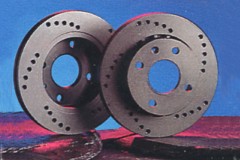
|
Cross drilled discs are so called because of the holes drilled into them (!). These holes help disperse heat, reducing brake fade. | |||||||||||||||
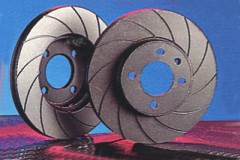
|
Grooved discs help to de-glaze the pads. This ensures greater friction between the pad and the disc. They will wear them out faster though. | |||||||||||||||
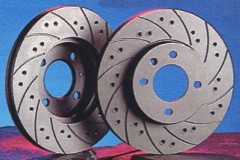
|
Drilled and grooved discs combine both technologies. These discs are therefore more expensive than x-drilled or grooved. | |||||||||||||||
| Uprated pads | ||||||||||||||||
| These pads are available in a variety of compounds, depending on their intended use. The names vary, depending on manufacturers. EBC's range are named as follows. Fast road pads are designed for tuned road cars and perform well at low to medium temperatures. This is the type recommended for road going modified cars. Rally formula pads have a slightly higher operating temperature range, and are designed for rally and light track use. Race formula pads have the highest operating range and are only suitable for hard track use. The compound of these pads is most effective at the extreme temperatures generated by track use and would perform very poorly on a road car until the pads heated up considerably. Fast road pads have a much lower optimum range, so they are effective when cold as well as under hard use. The temperature is never going to reach that of race cars, so the level of brake fade at that heat is not a consideration. | ||||||||||||||||
| Mintex, Ferrodo, Tar-Ox and Pagid all produce pads for the Fiesta. EBC's Greenstuff pads came out top in recent magazine test and are formulated to produce 80% less brake dust than similar pads. Ideal for show cars with expensive or difficult to clean alloys. | ||||||||||||||||
| Large diameter discs | ||||||||||||||||
| As explained above, simply swapping the discs will help under hard braking, but make little noticeable difference to the overall feel and effectiveness of the brakes. In order to increase the car's stopping power, other methods have to be employed. The first method, explained here is increasing the leverage on the disc. | ||||||||||||||||
| If you imagine your cars wheel, with the car jacked up so the wheel car turn freely. If you put your hand on on of the spokes, near the centre of the wheel and try and turn the wheel, considerable effort is required to make the wheel turn. now if you place your hand on the edge of the rim and do the same, a great deal less effort is needed. This is the same principle with large diameter discs. The larger size gives the caliper more leverage to stop the disc rotating, slowing the car down quicker. | ||||||||||||||||
| There are two factors that limit the maximum size of disc that can be used: | ||||||||||||||||
| 1. | The size and type of wheel. If the car still has 14" rims, huge discs physically won't fit behind the wheels. The other point to take into consideration is the spoke design of the wheel. "Deep Dish" wheels such as the TSW Big Deep, have spokes that curve inwards, towards the centre of the wheel. The design of the wheel may mean that with big discs fitted, the caliper comes into contact with the spokes. On the opposite end of the spectrum, wheels like the Evo R have spokes that extend beyond the tyre mounting edge of the rim, giving more clearance behind the spokes. | |||||||||||||||
| 2. | How far the caliper can be spaced out. All large disc conversion kits come with a mounting bracket to move the caliper father out towards the edge of the disc. The largest disc kit that works with standard calipers at the time of writing is 305mm. Larger discs can be used with replacement calipers. | |||||||||||||||
| The table below shows the size of wheel in relation to the maximum disc size that will fit. They will be differences depending on rim design, offset and wheel width. | ||||||||||||||||
|
||||||||||||||||
| Although the size of the disc is increased, when using standard calipers, the area that comes into contact with the pads remains the same. This leads to rust towards the centre of the disc, that will not be removed by the pad when braking. Another consideration is the size of the disc leads to a gain in the car's rotating weight, which can affect handling. As a result of these problems, the larger discs (300mm +), come with as bells and rotors, rather than a solid disc. The bell is the alloy centre of the disc, that mounts onto the wheel hubs, and the rotor is the part the calipers will grip. Having the bells made from alloy saves weight, and as all the surface area on the rotors will come into contact with the pads, there is no area that will be left rusty. The photo below shows the grooved rotors and yellow bells. | ||||||||||||||||
|
|
Brembo brake kit with separate bells and rotors. |
|||||||||||||||
| Large disc kits are available from Rally Design, Hi-Spec, Godspeed and The Braking Point. | ||||||||||||||||
| Brake Anatomy | ||||||||||||||||
|
|
||||||||||||||||
| Cosworth discs and calipers | ||||||||||||||||
| The second method of increasing braking power is to change the calipers for units that can grip the disc harder. This is fairly self explanatory, the harder the caliper can squeeze, the quicker the car will stop.The most common brake upgrade on tuned Fiestas is the set up from a Cosworth. This consists of the single pot calipers and 285mm discs. The Sapphire 4x4 and Escort systems will fit straight on, and the 4 pot calipers from the 2wd cars fits with a spacer bracket. Both discs and calipers are readily available, with many Cosworth owners having upgraded to AP or other high-spec set ups. | ||||||||||||||||
| The Cosworth calipers can be used with the larger discs as mentioned above. | ||||||||||||||||
|
|
Fiesta Frenzy Ian Howell's 430bhp Type R, with Escort Cosworth calipers and 315mm cross drilled Fiesta Frenzy discs. |
|||||||||||||||
| Many tuning companies offer this conversion, as well as brake specialists like Godspeed. The cost varies depending on condition of the units and where they are purchased from, but expect to pay around £400 fitted. In theory it should be possible to fit an aftermarket kit designed for an Escort Cosworth, as logic suggests that if Escort brakes fit, any brakes constructed to fit an Escort will also fit. Tar-Ox and AP Racing both produce kits for the Escort, though due to the light weight of the Fiesta, even 400bhp plus examples do not require this level of braking power. | ||||||||||||||||
| 4 pots | ||||||||||||||||
| The calipers Ford fitted to the Fiesta are single pot. This means there is one piston inside the caliper that pushes the pad on to the disc. Many high spec aftermarket calipers use four or more pistons. This is for two reasons. The additional pistons provide more force to squeeze the disc with, and with more than one piston, the force is more spread out over the pad area. | ||||||||||||||||
| 2wd Sierra Cosworth's have 4 pot calipers, and a pair of these can be picked up for around £150. As they are likely to be at least 10 years old, it is advisable to have them reconditioned if they have not already been. Any brake specialist should be able to carry this out. | ||||||||||||||||
| Wilwood produce one of the largest ranges of 4 pot calipers. Most of their units are designed for racing, and therefore lack the dust seals necessary for road use. The Dynalite and Superlite calipers are dust sealed and are suitable for road cars. | ||||||||||||||||
|
|
Wilwood Dynalite billet caliper |
|||||||||||||||
|
|
Wilwood Superlite II billet caliper |
|||||||||||||||
| The ultimate? | ||||||||||||||||
| Bremsport produce a kit for the Fiesta RS Turbo, based on 304mm rotors with anodised aluminium bells, 4 pot billet calipers and carbon metallic pads. The kit also contains high tensile mounting brackets and performance brake fluid. you will need to have 16" wheels to fit the kit, probably not a problem if you can afford the £900 (plus fitting) asking price... | ||||||||||||||||
|
|
Bremsport Fiesta RS Turbo kit 304mm rotors |
|||||||||||||||
| Rear disc conversions | ||||||||||||||||
| It is possible to fit rear discs to the Fiesta, but it's really only for looks rather than function. Something like 80% of the braking on the car is done by the front brakes. The rears don't really do much at all, hence Ford's decision to fit drums, even to the high performance models. This also saves money of course. Discs are obviously going to work better than drums, so if you have discs on the rear the rear brakes will be more effective. This will upset the brake balance and if you drive around with it set like that, you can imagine what happens the first time you brake while cornering. The back end will step out and the whole car will spin out. Not good. | ||||||||||||||||
| You can't have the discs set to work better that the original drums, so their only function now is to look good. They do look better than drums, but the cost of fitting discs is fairly expensive. | ||||||||||||||||
| If you do want to fit them the parts required are as follows: | ||||||||||||||||
| 1. | the discs - Escort RS2000 MK5/MK6 or Sierra 2wd rears are usually used | |||||||||||||||
| 2. | calipers - Escort RS2000 MK5/MK6 or Sierra 2wd rears | |||||||||||||||
| 3. | a brake bias valve - to adjust the balance between front and rear. | |||||||||||||||
| 4. | a handbrake cable - from an Escort RS2000 MK5/MK6 | |||||||||||||||
| 5. | flexible brake hoses | |||||||||||||||
| 6. | brackets to mount the calipers | |||||||||||||||
| 7. | You will also need to modify your drums to use as hubs, the bell needs to be removed then machined down so the disc will fit over it. The total cost of the parts is around £400 plus fitting costs. Companies like Hi-Spec, Godspeed and Braking Point can supply kits for around £400-£500. | |||||||||||||||
| It's a little expensive just to look good, and it's better to spend it on the front brakes. It's possible to get 4x4 Cosworth calipers and 285-315mm discs for that sort of money. | ||||||||||||||||
| Braided hoses. | ||||||||||||||||
| A worthwhile upgrade that eliminates that "spongy" pedal feel, caused by the brake lines flexing. The braided hoses are a lot less flexible, resulting in a firmer pedal action and instant response. Black Diamond and Goodridge both produce kits for the Fiesta, at round £40. | ||||||||||||||||
| Links | ||||||||||||||||
|
www.wilwood.com |
Wilwood, USA |
|||||||||||||||
